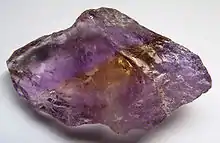Ametrine
Ametrine, also known as trystine or by its trade name as bolivianite, is a naturally occurring variety of quartz. It is a mixture of amethyst and citrine with zones of purple and yellow or orange. Almost all commercially available ametrine is mined in Bolivia.
| Ametrine | |
|---|---|
 Ametrine Emerald Cut | |
| General | |
| Category | Silicate mineral |
| Formula (repeating unit) | Silica (silicon dioxide, SiO2) |
| Crystal system | Hexagonal |
| Identification | |
| Formula mass | 60.08 g/mol |
| Color | Purple , Yellow |
| Crystal habit | 6-sided prism ending in 6-sided pyramid (typical) |
| Twinning | Dauphine law and Brazil law |
| Cleavage | none |
| Fracture | Conchoidal |
| Mohs scale hardness | 7 |
| Lustre | Vitreous |
| Streak | white |
| Diaphaneity | Transparent to translucent |
| Specific gravity | 2.65 |
| Optical properties | Unixal (+) |
| Refractive index | nω = 1.543–1.553 nε = 1.552–1.554 |
| Birefringence | +0.009 |
| Pleochroism | Amethyst section shows weak to moderate purple/reddish purple Citrine section shows very weak yellow/orange [1] |
| Melting point | 1650±75 °C |
| Diagnostic features | Distinct segments that are purple and yellow |
| Solubility | Insoluble in common solvents |
| Common impurities | Iron |
The colour of the zones visible within ametrine are due to differing oxidation states of iron within the crystal. The citrine segments have oxidized iron while the amethyst segments are unoxidized. The different oxidation states occur due to there being a temperature gradient across the crystal during its formation. Artificial ametrine is created from natural citrine through beta irradiation (which creates an amethyst portion), or from an amethyst that is turned into citrine through differential heat treatment.[2]
Ametrine in the low price segment may stem from synthetic material. Green-yellow or golden-blue ametrine does not exist naturally. This gem only exists in Bolivia, it comes from the Ricón del Tigre area, from the Anahí mine.
Structure
Ametrine is composed of silicon dioxide (SiO2) and it is a tectosilicate, which means it has a silicate framework linked together through shared oxygen atoms.
History
Legend has it that ametrine was first introduced to Europe by a conquistador's gifts to the Spanish Queen in the 1600s, after he received a mine in Bolivia as a dowry when he married a princess from the native Ayoreos tribe.[3]
References
- "Ametrine Value, Price, and Jewelry Information". International Gem Society. Retrieved 2019-09-14.
- "What does Amethyst, Ametrine and Citrine have in common?". Gem Rock Auctions. Retrieved 2019-09-15.
- Vasconcelos, Paolo; Wenk, Hanz-Rudolf; Rossman, George. "The Anahí Ametrine Mine, Bolivia," Gems and Gemology, Spring 1994, p. 4-23
External links
| Wikimedia Commons has media related to Ametrine. |
- Ametrine at the International Colored Gemstone Association
- Ametrine: Mineral Information Page
- Ametrine: Ametrine mineral information and data
- Insider Gemologist: What Are the Identifying Characteristics of Citrine, Ametrine, Smoky Quartz, and Scapolite? Archived September 5, 2006, at the Wayback Machine
